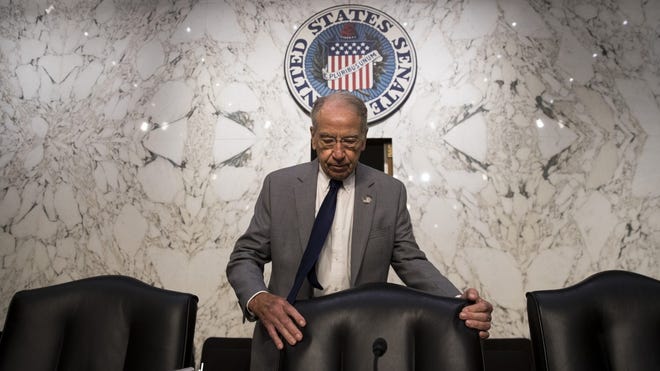
Cleveland native Brandon Chappo spent a year trying to figure out why he was sick.
The former air traffic controller said he his job used to be adapting quickly. But suddenly, he was having trouble learning new information. Chappo, 32, had one mysterious symptom after another, from persistent headaches to severe fatigue.
Chappo saw numerous physicians and specialists, costing him thousands of dollars, but no one could figure out what was wrong until a physician in Cleveland asked him what his living arrangements were.
"I'll never forget it," Chappo said. "She took her glasses off and said, 'Tell me why this isn't a good story for mold."
Chappo said no other medical provider brought up mold as a possibility.
"It upended my life," Chappo said. "So I began to think 'I wonder what other folks are thinking about this?'"
The health dangers of mold
While there is little to no data on the impact of mold on Ohioans or even nationally, a simple Facebook search brings up national support groups for people affected by mold with tens of thousands of members. The best current estimate for the number of homes with mold is 70%, although this number does not differentiate between toxic mold and harmless mold.
Ohio's residential property disclosure form claims "every home contains mold."
Dr. Summit Shah from Premier Allergy and Asthma in Central Ohio said the most common health issue related to mold is an allergic reaction to mold spores, which are in the air. In rare circumstances, a patient who is immunocompromised can have serious and even life-threatening symptoms when exposed to toxic mold. The second most common issue can affect anyone – if a patient is exposed to toxic mold, they may suffer from a long list of confusing symptoms.
"A lot of patients are confused because they're experiencing symptoms but they don't know what to attribute it to," Shah said. "They say that every time I walk into my apartment, I experience symptoms, but when I leave this place for a week, all my symptoms go away."
School counselor Katie DiNardo was one of those confused patients. When she and her husband moved into a new house in Stow in Summit County, her whole family – including her newborn daughter – started having strange symptoms.
"We always joked it was the house that was making us sick – never really thinking it was," DiNardo said.
DiNardo said her husband began to have respiratory issues, and she was experiencing a host of symptoms, including insomnia, gastrointestinal issues and anxiety. Her daughter was having trouble sleeping and developed eczema.
After being diagnosed with exposure to mold toxicity, DiNardo and her family left their home and now live in a mold-free home in Streetsboro in Portage County. DiNardo said her family has recovered and her second baby, who was born in a toxic mold-free environment, was a much healthier baby than her first.
"If we had known about this before we bought our first home, our path would've been a lot different," DiNardo said. "We would've known that mold is not something you just mess around with."
A legislative solution?
When Chappo moved out of his mold-infested home, his new representative was Rep. Joe Miller, D-Amherst. Chappo decided to tell Miller what happened.
Samantha Rocco, Miller's legislative aide, answered his email. Rocco had a run-in with mold while living off-campus as a student at Ohio State University, so she knew about the dangers. She set up a call between Chappo and Miller.
Eight months later, Miller and Rep. Russo, D-Upper Arlington, introduced House Bill 251, the Ohio Indoor Safe Air Act, to establish an indoor mold awareness program in Ohio.
The bill would put toxic mold in line with lead and radon – so when an Ohioan rents or purchases a home, they would be given an educational pamphlet about mold and informed if there is mold in the home. However, the bill wouldn't regulate the level of mold in a residence. There are currently no regulations on the level of mold in a residence, either federally or in Ohio.
Russo, a public health policy expert, called the bill a "good first step." The bill will require the Ohio Department of Health director to review mold toxicity treatments and technology every five years. Russo said a focused effort by the health department will help determine what kind of regulations are necessary.
The bill currently does not have bipartisan support and has not had any hearings scheduled, but Rep. Russo is optimistic the bill will have a hearing in the fall. Chappo said he hopes the bill will eventually receive bipartisan support, as the issue affects everyone regardless of background.
What you can do to protect yourself from mold
Certified mold inspector Chuck Billingsley said he sees houses that "aren't even a month old" and are already infested with toxic mold.
"A lot of clients don't know," said Billingsley, who runs a mold inspection company in Brown County called Thur-O-Check Environmental. "A lot of them aren't educated enough about mold until they start getting sick or smell something nasty in the basement."

If you suspect you have mold, Shah, the allergist, said you shouldn't try a "Band-Aid solution" by attempting to get rid of it yourself. He recommends getting out of your current living environment as soon as possible until the mold is completely gone. Mold doesn't have any long-term side effects. But if you don't leave the mold-infested environment, Shah said, you may have continual problems.
One way you might be able to tell you're living with mold before you even exhibit symptoms is through your pets. Shah said pets will often act strange or exhibit symptoms before people do, so if your pets start acting strange, it's time to get your house tested for mold.
Billingsley, known by some of his clients as the "Mold Whisperer," recommends calling an independent third-party testing firm if you suspect you have mold. According to Billingsley, firms that don't also offer mold removal are more likely to give you more accurate information because they don't have a conflict of interest.
If you do have mold, Billingsley said to hire a separate mold removal company and check testimonials online to make sure they're legitimate.
Grace Deng is a reporter for the USA TODAY Network Ohio Bureau, which serves the Columbus Dispatch, Cincinnati Enquirer, Akron Beacon Journal and 18 other affiliated news organizations across Ohio.
Source link








